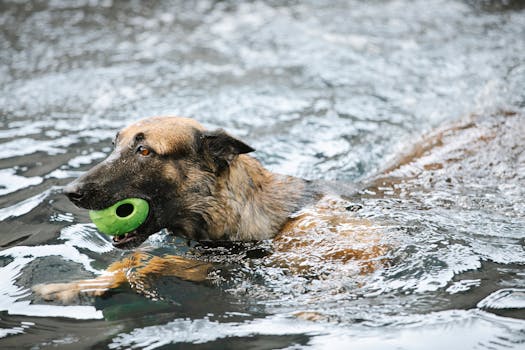Keeping Your Canine Cool: Essential Tips for Dog Owners During Summer

As temperatures rise during the summer months, it's important to ensure that our furry friends remain comfortable and safe. Dogs are particularly vulnerable to heat due to their limited ability to sweat and cool down. This guide will provide you with comprehensive strategies to keep your dog cool while enjoying the great outdoors.
Understanding Heat Sensitivity in Dogs
Before diving into specific methods, it’s crucial to understand why dogs are so sensitive to heat. Unlike humans, dogs primarily regulate their body temperature through panting and limited sweating through their paw pads. This makes them less efficient at cooling down, which can lead to heat exhaustion or even heat stroke if not properly managed.
Recognizing Signs of Overheating
Recognizing the signs of overheating in dogs is the first step in preventing serious health issues. Symptoms include excessive panting, drooling, lethargy, confusion, vomiting, and in severe cases, collapse. Always be vigilant and responsive if your dog displays any of these signs.
Hydration is Key
One of the most critical factors in keeping your dog cool is ensuring they stay hydrated. Always provide fresh water for your dog to drink throughout the day. Consider carrying a portable water bottle and bowl when you’re out on walks or excursions. Adding ice cubes to their water bowl can also help keep it cool for longer periods.
Shade and Shelter
Providing adequate shade is essential when your dog is outside. Natural shade from trees or artificial shade from umbrellas or tents can offer a cooler environment for your pet. If your yard lacks natural shade, consider investing in a high-quality outdoor canopy or constructing a simple shelter to protect your dog from direct sunlight.
Timing Outdoor Activities
Plan outdoor activities during cooler parts of the day, such as early morning or late evening. Avoid walking your dog during peak heat hours (10 AM to 4 PM) when the sun is at its strongest. Additionally, be mindful of hot pavement and sand, which can burn your dog's paw pads. Test the ground with your hand; if it’s too hot for you, it’s too hot for them.
Cooling Products
There are various cooling products available that can help keep your dog comfortable:
1. Cooling Vests: These vests are designed to be soaked in water and then worn by your dog. As the water evaporates, it provides a cooling effect.
2. Cooling Mats: These mats often contain gel that stays cool without needing refrigeration. They offer a cool surface for your dog to lie on.
3. Fans and Misters: Portable fans or misters can create a breeze and reduce the ambient temperature around your dog.
Grooming Considerations
Regular grooming can also help manage your dog's temperature. While it might seem logical to shave off all their fur, this isn’t always advisable as their coat can actually protect against sunburn and overheating. Instead, maintain a well-groomed coat by brushing regularly to remove excess fur and prevent matting.
Providing Frozen Treats
Frozen treats can be both refreshing and hydrating for dogs during summer. You can make simple frozen treats using ingredients like plain yogurt, peanut butter (ensure it's xylitol-free), and fruits like blueberries or bananas. Freeze these ingredients in ice cube trays or silicone molds for a delicious cooling snack.
Swimming and Water Play
Many dogs love water, making swimming an excellent way for them to stay cool while getting exercise. Whether it's a pool, lake, or even a kiddie pool in your backyard, supervised water play can be extremely beneficial. Always ensure safety by monitoring your dog closely around water bodies and providing a life jacket if necessary.
Avoiding Hot Cars
Never leave your dog in a parked car during warm weather, even with windows cracked open. Temperatures inside cars can soar rapidly, leading to fatal heatstroke within minutes. If you need to run errands where dogs aren’t allowed inside, it's best to leave them at home in a cool environment.
Vet Check-ups
Regular veterinary check-ups are important year-round but especially crucial during summer months. Your vet can provide specific advice tailored to your dog's breed, age, and health status regarding heat management.
Recognizing Breed-Specific Needs
Certain breeds are more prone to overheating due to their physical characteristics:
- Brachycephalic Breeds: Breeds like Bulldogs, Pugs, and Boxers have short noses that make breathing harder in hot weather.
- Thick-Coated Breeds: Breeds like Huskies and Malamutes have dense fur that traps heat.
- Senior Dogs: Older dogs may have reduced mobility and health conditions that make them more vulnerable.
For these breeds and age groups, extra precautions should be taken to ensure they remain cool and comfortable.
Creating a Cool Environment Indoors
When it's simply too hot outside, creating a cool indoor environment becomes essential:
- Air Conditioning: Ensure that your home is adequately cooled with air conditioning or fans.
- Cool Zones: Designate areas with tile flooring or basements where it tends to be cooler.
- Limit Activity: On particularly hot days, reduce physical activity indoors as well.
Conclusion
Summer can be an enjoyable time for both you and your canine companion if proper precautions are taken. By staying vigilant about hydration, providing ample shade and cooling options, planning activities during cooler times of the day, and recognizing signs of overheating early on, you can ensure that your dog remains happy and healthy throughout the warmer months.
Remember that each dog is unique; what works for one may not work for another. Pay attention to your dog's specific needs and preferences when implementing these strategies. By taking these steps seriously, you're not only enhancing their comfort but also safeguarding their well-being against the dangers of summer heat.